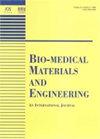利用计算机视觉识别细胞集体迁移中丝状足的领导细胞。
IF 1
4区 医学
Q4 ENGINEERING, BIOMEDICAL
引用次数: 0
摘要
背景细胞和细胞器的成像一直受到研究人员和医务人员的极大兴趣,因为它可以提供有关细胞生理学和病理学的有用信息。已经建立了许多与集体细胞迁移有关的研究,引导细胞似乎是调节迁移的细胞,然而,引导细胞的识别非常耗时。目的本研究利用计算机视觉和深度学习来分割细胞形状,并通过丝足识别引导细胞。方法在聚二甲基硅氧烷(PDMS)微通道装置中培养的健康Madin-Darby犬肾脏(MDCK)细胞允许细胞集体迁移以及形成引导细胞。对细胞进行染色,并使用UNet++以及使用Photoshop创建的用于自动细胞分割的相应掩模捕获细胞图像以训练计算机。最后,使用Filopodyan过滤细胞形状和丝状体,并检测FiloQuant。结果细胞形状的分割和丝状伪足的识别是成功的,每张图像在不到1秒的时间内产生了准确的结果。结论所提出的图像分析方法将对细胞科学、工程和诊断领域有很大帮助。本文章由计算机程序翻译,如有差异,请以英文原文为准。
Identification of leader cells by filopodia in collective cell migration using computer vision.
BACKGROUND
Imaging of cells and cellular organelles has been of great interest among researchers and medical staff because it can provide useful information on cell physiology and pathology. Many researches related to collective cell migration have been established and leader cells seem to be the ones that regulate the migration, however, the identification of leader cells is very time-consuming.
OBJECTIVE
This study utilized computer vision with deep learning to segment cell shape and to identify leader cells through filopodia.
METHODS
Healthy Madin-Darby Canine Kidney (MDCK) cells cultured in a Polydimethylsiloxane (PDMS) microchannel device allowed collective cell migration as well as the formation of leader cells. The cells were stained, and cell images were captured to train the computer using UNet++ together with their corresponding masks created using Photoshop for automated cell segmentation. Lastly, cell shape and filopodia were filtered out using Filopodyan and FiloQuant were detected.
RESULTS
The segmentation of cell shape and the identification of filopodia were successful and produced accurate results in less than one second per image.
CONCLUSIONS
The proposed approach of image analysis would be a great help in the field of cell science, engineering, and diagnosis.
求助全文
通过发布文献求助,成功后即可免费获取论文全文。
去求助
来源期刊

Bio-medical materials and engineering
工程技术-材料科学:生物材料
CiteScore
1.80
自引率
0.00%
发文量
73
审稿时长
6 months
期刊介绍:
The aim of Bio-Medical Materials and Engineering is to promote the welfare of humans and to help them keep healthy. This international journal is an interdisciplinary journal that publishes original research papers, review articles and brief notes on materials and engineering for biological and medical systems. Articles in this peer-reviewed journal cover a wide range of topics, including, but not limited to: Engineering as applied to improving diagnosis, therapy, and prevention of disease and injury, and better substitutes for damaged or disabled human organs; Studies of biomaterial interactions with the human body, bio-compatibility, interfacial and interaction problems; Biomechanical behavior under biological and/or medical conditions; Mechanical and biological properties of membrane biomaterials; Cellular and tissue engineering, physiological, biophysical, biochemical bioengineering aspects; Implant failure fields and degradation of implants. Biomimetics engineering and materials including system analysis as supporter for aged people and as rehabilitation; Bioengineering and materials technology as applied to the decontamination against environmental problems; Biosensors, bioreactors, bioprocess instrumentation and control system; Application to food engineering; Standardization problems on biomaterials and related products; Assessment of reliability and safety of biomedical materials and man-machine systems; and Product liability of biomaterials and related products.
 求助内容:
求助内容: 应助结果提醒方式:
应助结果提醒方式:


